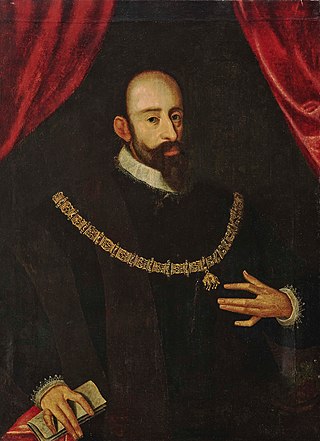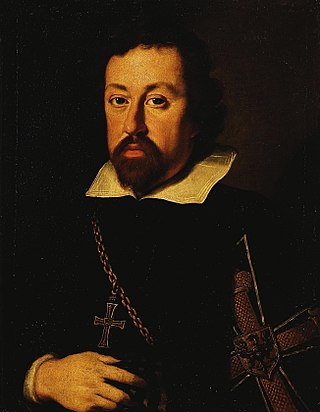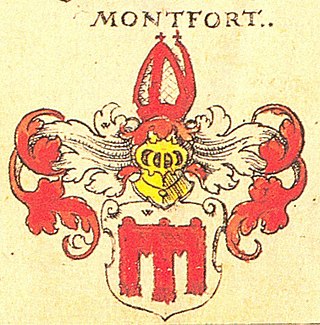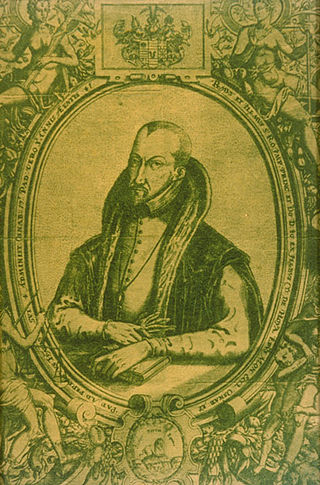Related Research Articles

Matilda of Ringelheim, also known as Saint Matilda, was a Saxon noblewoman. Due to her marriage to Henry I in 909, she became the first Ottonian queen. Her eldest son, Otto I, restored the Holy Roman Empire in 962. Matilda founded several spiritual institutions and women's convents. She was considered to be extremely pious, righteous and charitable. Matilda's two hagiographical biographies and The Deeds of the Saxons serve as authoritative sources about her life and work.
Pope Damasus II was the head of the Catholic Church and ruler of the Papal States from 17 July 1048 to his death on 9 August that same year. He was the second of the German pontiffs nominated by Emperor Henry III. A native of Bavaria, he was the third German to become pope and had one of the shortest papal reigns.

William V, called the Pious, was Duke of Bavaria from 1579 to 1597.

Henry IX, called the Black, a member of the House of Welf, was Duke of Bavaria from 1120 to 1126.
Henry, of the House of Ardenne–Luxembourg, was the count of Luxembourg from 998 and the duke of Bavaria from 1004. He was the son of Siegfried I of Luxembourg and Hedwige of Nordgau.

ArchduchessMaria Elisabeth of Austria, was the governor of the Habsburg Netherlands between 1725 and 1741.

Maria Magdalena, Archduchess of Austria was a governor of Tyrol and daughter of Emperor Leopold I and his third wife Eleonore Magdalene of the Palatinate. She died unmarried.

Johann Heinrich Schönfeld (1609–1684) was a German painter in the Baroque style.
Hezilo of Hildesheim, also known as Hezelo, Hettilo or Ethilo, was Bishop of Hildesheim from 1054 to 1079.

Henry of Saxe-Lauenburg was a Prince-Archbishop of Bremen, then Prince-Bishop of Osnabrück, then Prince-Bishop of Paderborn.

Charles, Margrave of Burgau, also known as Charles of Austria,, was the son of Archduke Ferdinand II of Austria and his first morganatic marriage to Philippine Welser. He was the brother of Andrew of Austria.

Hartmann von Dillingen was Bishop of Augsburg from 1248 until his death.

Charles of Austria, nicknamed the Posthumous, a member of the Imperial House of Habsburg, was Prince-Bishop of Wrocław (Breslau) from 1608, Prince-Bishop of Brixen from 1613, and Grand Master of the Teutonic Order from 1618 until his death. In 1621 he also received the Bohemian County of Kladsko as a fief from the hands of his brother, Emperor Ferdinand II.
Adalbero III of Luxembourg was a German nobleman. He was a titular Count of Luxembourg and Bishop of Metz.

Rudolf of Wied was anti-Archbishop of Trier from 1183–1189. He was a supporter of the Holy Roman Emperor Frederick I Barbarossa in the late twelfth century phase of the Investiture Controversy.

Marquard Rudolf Reichsritter von Rodt zu Bußmannshausen, or Roth was, from 1689 to 1704, the prince-bishop of the Bishopric of Constance.

Rudolf III von Montfort was bishop of Chur (1322–1325) and Konstanz (1322–1334). He was born into the young family of Montfort-Feldkirch of the Swabian noble family of Montfort.

Johann IV of Osnabrück was a German nobleman and prince-bishop. From his father Johann VII's death in 1535 onwards he was known as Count (Graf) Johann VIII von Hoya zu Stolzenau. From 1553 he was Prince-Bishop of Osnabrück, then from 1566 Prince-Bishop of Münster and finally from 1568 administrator of the Bishopric of Paderborn.

Arnold II of Isenburg was Archbishop of Trier from 1242 to his death. A long-time member of the cathedral chapter in Trier, he held several provostships before being elected as archbishop, succeeding his uncle Theoderich von Wied. The election was controversial, and king Conrad IV of Germany granted the regalia to Rudolf de Ponte, the opposing candidate, instead. Arnold was confirmed as archbishop by Pope Innocent IV and consecrated in 1245.
Egno von Eppan was the bishop of Brixen from 1240 to 1250, and then bishop of Trent until his death.
References
- ↑ The Hofkapelle was the central ecclesiastical institution of the imperial court, not to be confused with the later usage of the word which meant "court orchestra".
- ↑ Tyler, J. Jeffery. Lord of the Sacred City: The Episcopus Exclusus in Late Medieval and Early Modern Germany, Boston. BRILL, 1999, p. 80 ISBN 9789004111202